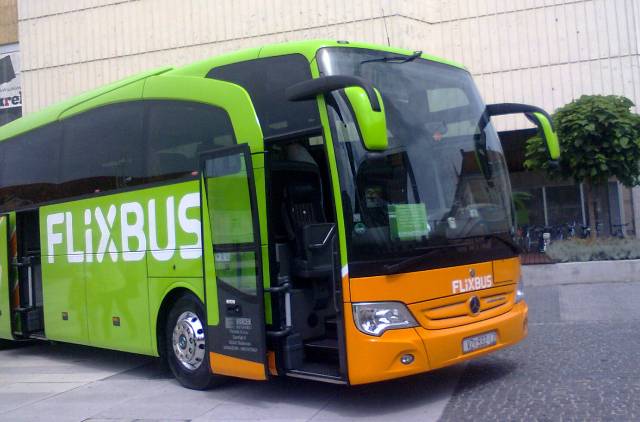For $10, you can take an Uber from the downtown Phoenix Arizona State University campus to the Phoenix Sky Harbor International airport. For four dollars less, you can take a Flixbus from the very same airport to downtown Tucson.
Flixbus, a German bus company seemingly offers the impossible: regular bus routes between California, Nevada and Arizona with tickets starting at just $2.99. Having taken the European bus industry by storm with similarly cheap prices, the company has invested in American southwest for their next expansion.
When morning coffee can end up costing more than a ticket, the deals seem almost too good to be true. At present, the most expensive route is a bus from Sky Harbor to San Francisco this Saturday at $80. However Michael Kahn, the head of business development for the company, assures travelers that the prices are so low thanks to the company’s business model.
“Our business model is sort of similar to Uber, in that we don’t own any of the vehicles ourselves,” Kahn said.
The company instead partners with local bus companies. While Flixbus is in charge of the company branding, ticket sales and marketing, their partners manage all other bus operations such as hiring drivers and maintaining buses.
“Working with these smaller bus companies that provide the buses and the service allows us to be more efficient,” he said. “We sort of split those responsibilities. We focus on what we do best, they focus on what they do best.”
According to Kahn, the prices are also kept low in hopes of attracting more customers.
“The game we’re playing is more volume at lower prices,” he said.
Aside from their prices, the company hopes to draw customers and stand apart from local competitors like Greyhound Lines and Megabus by “bringing bus travel into 2018.”
Kahn described Flixbus as the answer to “an industry that has really not adapted to technology and not really been modernized.”
According to Kahn, the company focus is on quality and a “totally customer centric approach.”
All of the company’s buses in the U.S. offer onboard entertainment and wifi. Ticket sales are mainly done through the Flixbus website and app which also allow passengers to track their bus before a trip and will notify them of delays and cancellations.
Considering the company’s target audience – college students and millennials – Kahn said the company’s hope is to become something like Uber or Lyft just for long distance travel.
“It’s on your phone and you’re used to using it anytime you travel,” he said. “It’s the first thing that you check before you even look at flight options.”
For Lisa Sene, a sophomore at the University of Arizona, Flixbus has become her primary way of traveling between Tempe and Tucson.
Before Sene had relied on Greyhound routes between the two cities, but cited poor service, constant delays and ticket prices as reasons why she switched. For the Tucson to Tempe route, Flixbus’ tickets are anywhere from $10 to $15 cheaper.
“To get like from Tucson to Tempe or even like Tempe to L.A. or L.A. to northern California – I think it’s one of the cheapest options,” she said. “If someone – friends, family, anybody – really told me they needed to get somewhere, I’d definitely suggest it.”
While Flixbus has certainly gained attention with its pricing and promises, the company is not yet experiencing the successes it boasts in Europe.
Thomas Morgan, the CEO of Gray Line Arizona, says that while bus occupancies are rising – an assertion supported by Flixbus users – the company is not “not seeing the return on investments that [they] need.”
Gray Line, one of Flixbus’ Arizona partners, previously managed regular routes in Arizona, but sold them to other bus companies with the last route sold to Greyhound in the early 2000s.
“I won’t say we instantly regretted because the environment changes and its never simple doing these kinds of changes, but we did want to get back into regular route and [Flixbus] seemed like a good opportunity,” Morgan said.
Gray Line now manages the Tucson to Los Angeles route, an investment that has cost the company several million, according to Morgan.
While Morgan says business has increased over the past six months, Flixbus needs to take advantage of the steady stream of customers.
“Now we need to see whether we can start inching the prices up,” he said. “Flix really got a foothold in Europe. The real question is whether they can do the thing same thing down here in the United States.”
Regardless of the slow beginning, Morgan says Gray Line is hopeful that the partnership will be “lucrative in the long run” and he isn’t worried about increasing ticket prices.
“The real distinguishing factor in this market – a little bit is about the cost but a lot of it is about the service quality,” he said. “And the service quality that Flixbus offers is head and tails better than any of the other operators.”
Kahn is similarly hopeful for the future, especially as the company is working to expand to Texas and the Pacific Northwest.
“The truth is once people take the bus once, they often times come again,” he said. “If the price goes up by $5, or $5 it’s still so cheap compared to driving yourself or taking a flight that once people see the experience…they’ll come back.”




